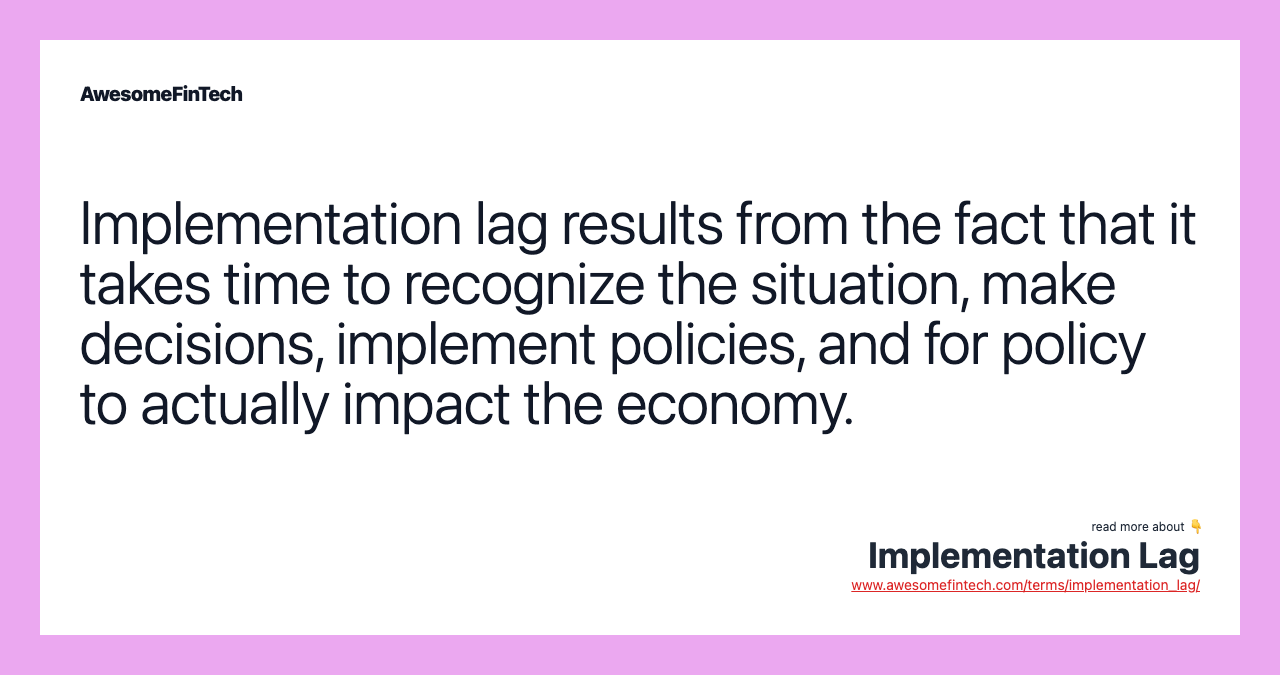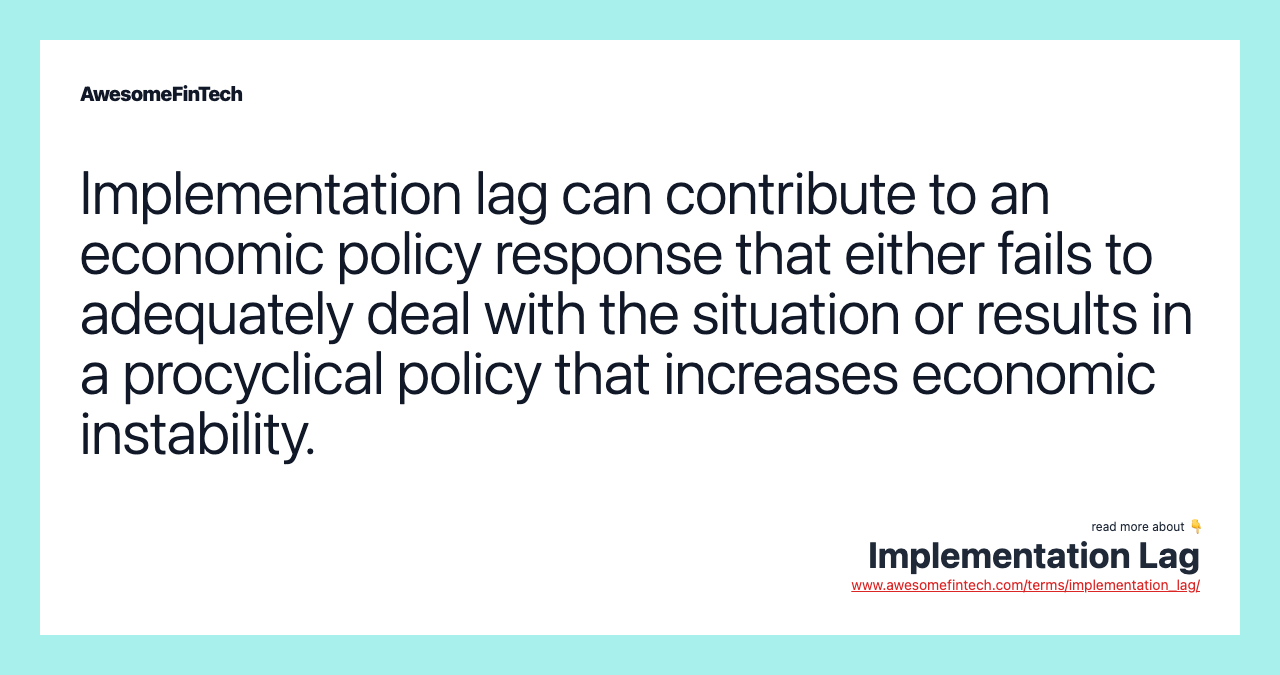Implementation Lag
Implementation lag is the delay between an adverse macroeconomic event and the implementation of a fiscal or monetary policy response by the government and central bank. Implementation lag can result from delays in recognizing a problem; disagreements and bargaining over the appropriate response; physical, technical, and administrative constraints on the actual execution of new policy; and structural economic lags as the policy change works its way through the economy. Because of all these delays, by the time an economic policy response to a negative economic shock or a downturn into recession actually works its way through the economy, the economic situation will inevitably have changed to some degree. Implementation lag can contribute to an economic policy response that either fails to adequately deal with the situation or results in a procyclical policy that increases economic instability. Implementation lag is a delay between the occurrence of a shift in macroeconomic conditions or an economic shock and the time that an economic policy response can be implemented and actually have an effect.

More in Economy
What Is Implementation Lag?
Implementation lag is the delay between an adverse macroeconomic event and the implementation of a fiscal or monetary policy response by the government and central bank. Implementation lag can result from delays in recognizing a problem; disagreements and bargaining over the appropriate response; physical, technical, and administrative constraints on the actual execution of new policy; and structural economic lags as the policy change works its way through the economy. Implementation lag may reduce the effectiveness of a policy response or even result in periods of procyclical policy.



Understanding Implementation Lag
There is always an implementation lag after a macroeconomic surprise. For one thing, policymakers may not even realize there is a problem, because of data lag. A lot of economic data is not published for a month or a quarter after the period it applies to. Even then, these lagging indicators may be subject to successive revisions. GDP data, for example, is notoriously unreliable when first published, which is why the Bureau of Economic Analysis warns that its estimates are informative, but never really final.
For an advance warning of economic threats, policymakers look at leading indicators, like surveys of business confidence, and bond and stock market indicators, like the yield curve — economists and policymakers still have to wait to see if these predictions come true. Then, because of recognition lag, it may take months or years before politicians recognize there has been an economic shock or structural change in the economy. Incumbent politicians may even be reluctant to acknowledge there is a chance of a recession until they are in the middle of one.
Central bankers, economists, and politicians then have to deliberate over the right response before they implement policy changes. The right policies will not necessarily be obvious, especially to economists. And politicians, who naturally have political rather than economic objectives, like to pass the buck. Good economics — like preventing massive asset bubbles that will devastate the economy when they burst — often make bad politics, and economists tend to disagree widely over what constitutes good economics in the first place. This is why the relationship between economics and politics leads to so many policy blunders, and why monetary policy so often ends up being procyclical and destabilizing rather than being countercyclical and helping to smooth out the economic cycle.
Even when economists and politicians are on the same page, there will still be a response lag, before any monetary or fiscal policy action has an impact on the economy. New government spending programs may take weeks or months to actually get the money in the hands of the ultimate recipients. Injections of new money into the economy also take time to work their way through the financial sector and the real economy, with long and variable lags between monetary policy changes and ultimate results. As quantitative easing has shown, it can take years before monetary policy has any real effect on the economy — as is the case when central banks push on a string — and tax cuts can take just as long to have a verifiable impact.
Because of all these delays, by the time an economic policy response to a negative economic shock or a downturn into recession actually works its way through the economy, the economic situation will inevitably have changed to some degree. It may be that the economic downturn has become more severe, and the initial policy response is now inadequate to address the situation. Or it may be that the economy has already begun to self-correct, and by the time the policy response takes effect it simply adds fuel to the fire of the next economic cycle or bubble. In this case, such policy tends to be procyclical and actually magnifies economic instability over time.
Related terms:
Economic Shock
An economic shock is an event that occurs outside of an economic model that produces a significant change within an economy. read more
Fool in the Shower
"Fool in the shower" describes how policymakers are prone to overshoot their intended outcomes because they do not account for the lag in economic matters. read more
Gross Domestic Product (GDP)
Gross domestic product (GDP) is the monetary value of all finished goods and services made within a country during a specific period. read more
Lagging Indicator
A lagging indicator is an observable or measurable factor that changes some time after the economic, financial, or business variable it is correlated with changes. read more
Leading Indicator
A leading indicator is an economic factor that can be used to predict which way a market or economy may go in the future. read more
Pushing On A String
Pushing on a string is a metaphor for the limits of monetary policy when households and businesses hoard cash in the face of a recession. read more
Recognition Lag
Recognition lag is the delay between when an economic shock occurs and when it is recognized by economists, central bankers, and the government. read more
Response Lag
Response lag is the time it takes for monetary and fiscal policies to affect the economy once they have been implemented. read more
Stagflation
Stagflation is the combination of slow economic growth along with high unemployment and high inflation. read more